Analysis of Leadership and Management in EWS Case Study - PROJ6006
VerifiedAdded on 2023/01/23
|10
|2558
|27
Report
AI Summary
This report analyzes the Ecological Wastewater Solutions (EWS) case study, focusing on leadership and project management within the company. The report identifies participative leadership as the most appropriate style for EWS, emphasizing the inclusion of team members in decision-making to boost morale and project success. It delves into the tools and techniques used to influence the project team, including interactive skills, conflict management, and leadership aspects. Furthermore, the report explores communication strategies, such as email, internal blogs, and private messaging. It also examines the five kinds of power employed in motivating team members, highlighting expert power as crucial for the project. Additionally, the report discusses techniques for developing self-managed teams in an agile project environment, emphasizing trust, honesty, and self-driven employees. Finally, it outlines steps a project manager can take to improve challenges, including employee engagement, task delegation, and effective meetings.
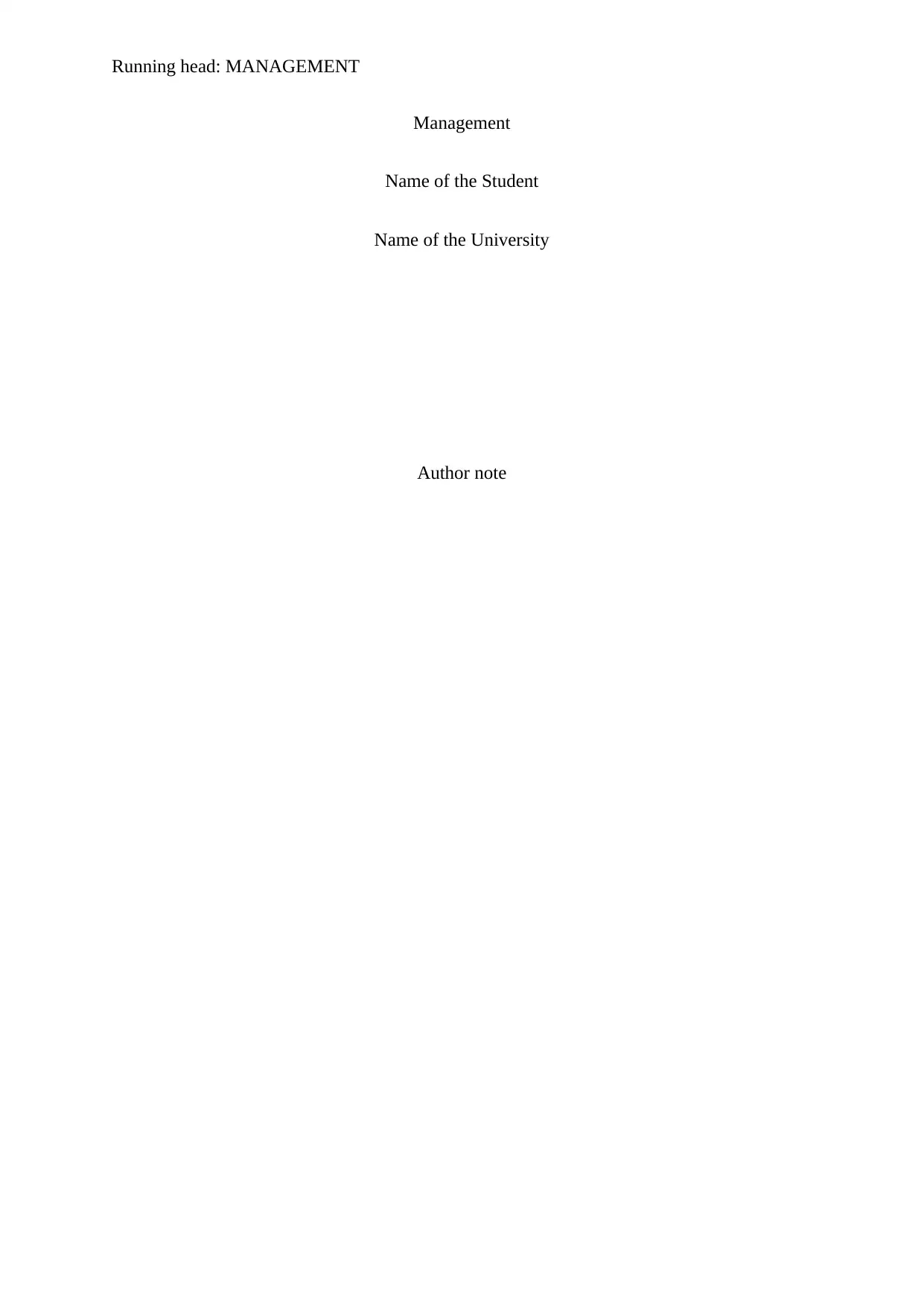
Running head: MANAGEMENT
Management
Name of the Student
Name of the University
Author note
Management
Name of the Student
Name of the University
Author note
Paraphrase This Document
Need a fresh take? Get an instant paraphrase of this document with our AI Paraphraser
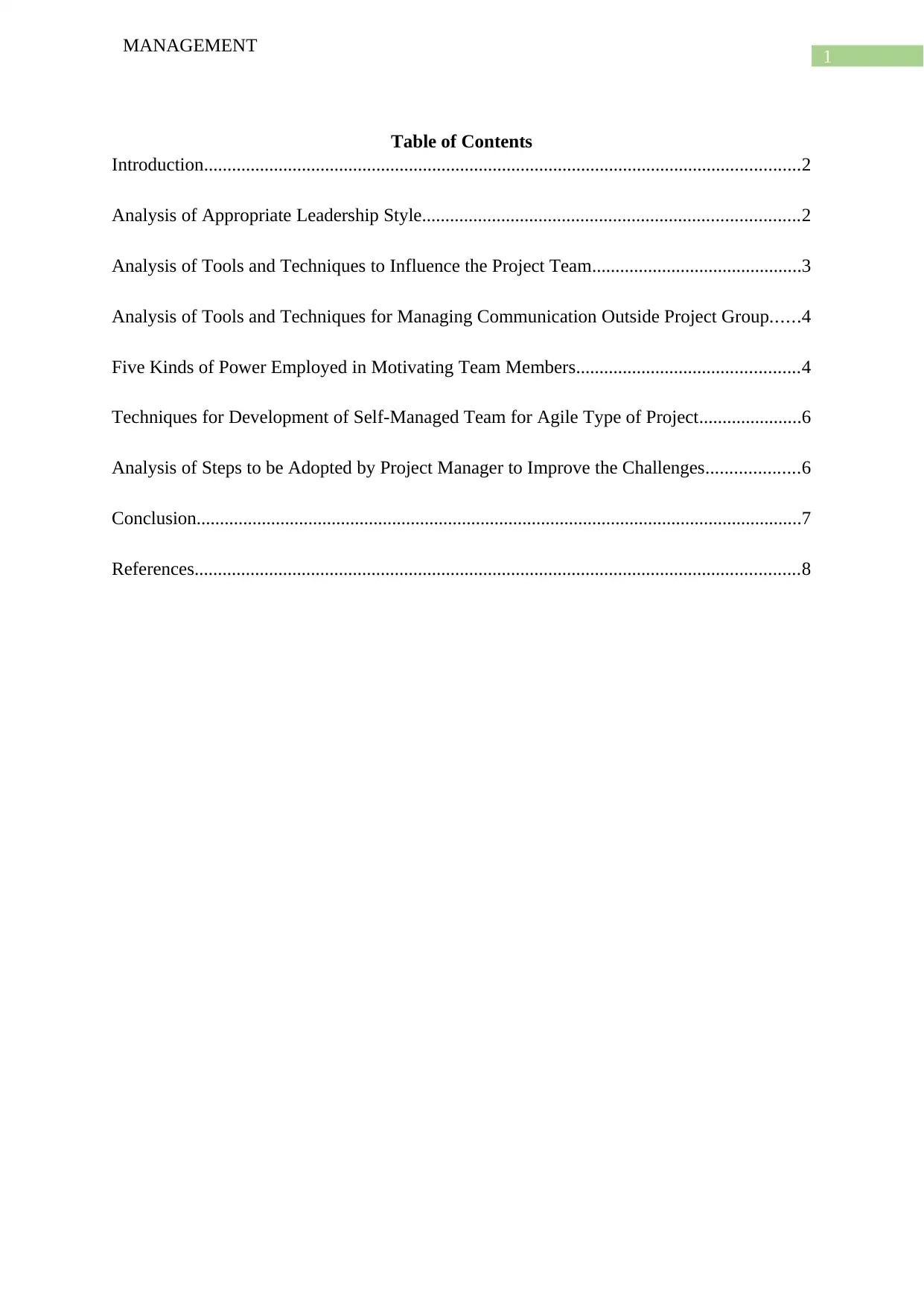
1
MANAGEMENT
Table of Contents
Introduction................................................................................................................................2
Analysis of Appropriate Leadership Style.................................................................................2
Analysis of Tools and Techniques to Influence the Project Team.............................................3
Analysis of Tools and Techniques for Managing Communication Outside Project Group......4
Five Kinds of Power Employed in Motivating Team Members................................................4
Techniques for Development of Self-Managed Team for Agile Type of Project......................6
Analysis of Steps to be Adopted by Project Manager to Improve the Challenges....................6
Conclusion..................................................................................................................................7
References..................................................................................................................................8
MANAGEMENT
Table of Contents
Introduction................................................................................................................................2
Analysis of Appropriate Leadership Style.................................................................................2
Analysis of Tools and Techniques to Influence the Project Team.............................................3
Analysis of Tools and Techniques for Managing Communication Outside Project Group......4
Five Kinds of Power Employed in Motivating Team Members................................................4
Techniques for Development of Self-Managed Team for Agile Type of Project......................6
Analysis of Steps to be Adopted by Project Manager to Improve the Challenges....................6
Conclusion..................................................................................................................................7
References..................................................................................................................................8
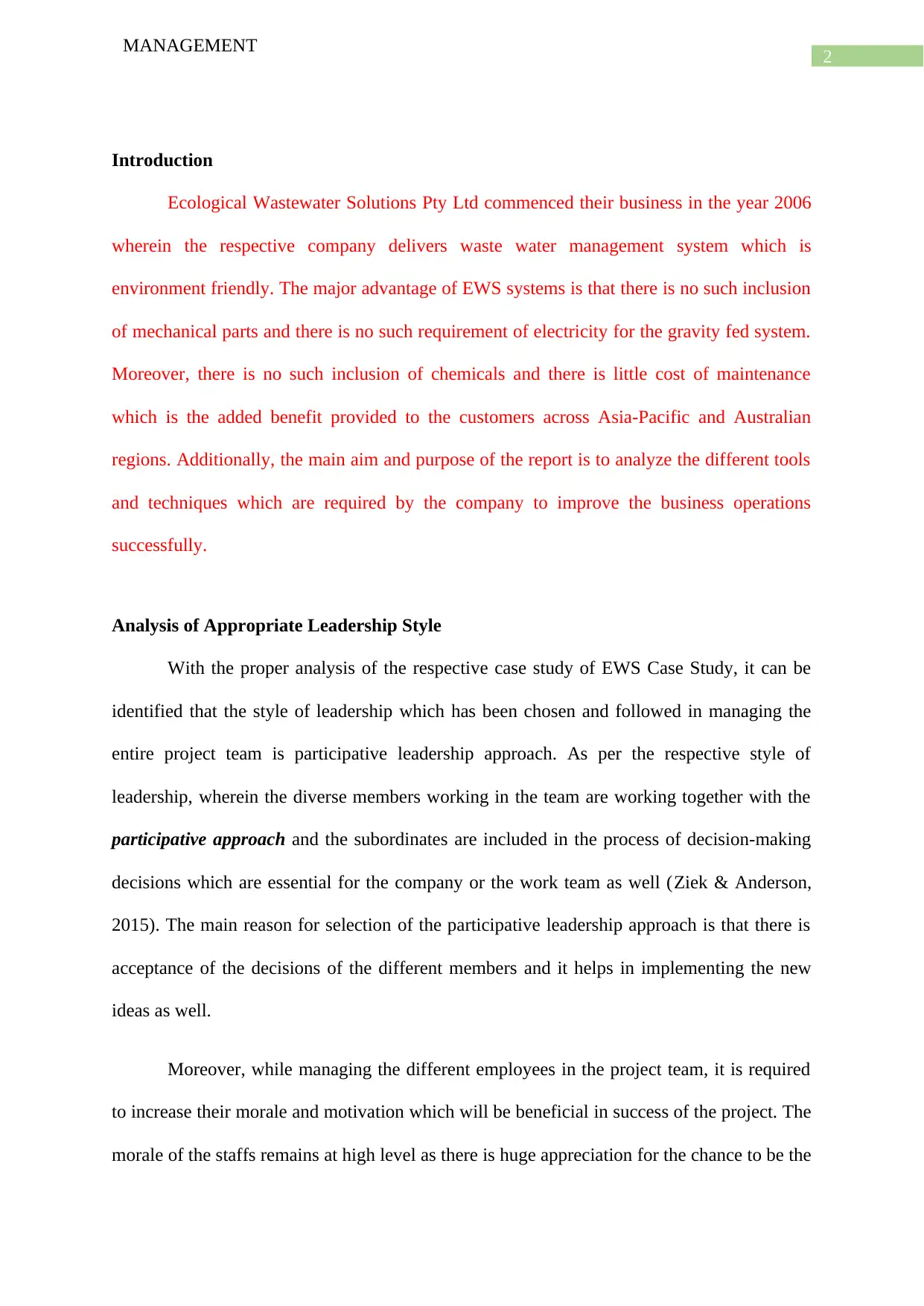
2
MANAGEMENT
Introduction
Ecological Wastewater Solutions Pty Ltd commenced their business in the year 2006
wherein the respective company delivers waste water management system which is
environment friendly. The major advantage of EWS systems is that there is no such inclusion
of mechanical parts and there is no such requirement of electricity for the gravity fed system.
Moreover, there is no such inclusion of chemicals and there is little cost of maintenance
which is the added benefit provided to the customers across Asia-Pacific and Australian
regions. Additionally, the main aim and purpose of the report is to analyze the different tools
and techniques which are required by the company to improve the business operations
successfully.
Analysis of Appropriate Leadership Style
With the proper analysis of the respective case study of EWS Case Study, it can be
identified that the style of leadership which has been chosen and followed in managing the
entire project team is participative leadership approach. As per the respective style of
leadership, wherein the diverse members working in the team are working together with the
participative approach and the subordinates are included in the process of decision-making
decisions which are essential for the company or the work team as well (Ziek & Anderson,
2015). The main reason for selection of the participative leadership approach is that there is
acceptance of the decisions of the different members and it helps in implementing the new
ideas as well.
Moreover, while managing the different employees in the project team, it is required
to increase their morale and motivation which will be beneficial in success of the project. The
morale of the staffs remains at high level as there is huge appreciation for the chance to be the
MANAGEMENT
Introduction
Ecological Wastewater Solutions Pty Ltd commenced their business in the year 2006
wherein the respective company delivers waste water management system which is
environment friendly. The major advantage of EWS systems is that there is no such inclusion
of mechanical parts and there is no such requirement of electricity for the gravity fed system.
Moreover, there is no such inclusion of chemicals and there is little cost of maintenance
which is the added benefit provided to the customers across Asia-Pacific and Australian
regions. Additionally, the main aim and purpose of the report is to analyze the different tools
and techniques which are required by the company to improve the business operations
successfully.
Analysis of Appropriate Leadership Style
With the proper analysis of the respective case study of EWS Case Study, it can be
identified that the style of leadership which has been chosen and followed in managing the
entire project team is participative leadership approach. As per the respective style of
leadership, wherein the diverse members working in the team are working together with the
participative approach and the subordinates are included in the process of decision-making
decisions which are essential for the company or the work team as well (Ziek & Anderson,
2015). The main reason for selection of the participative leadership approach is that there is
acceptance of the decisions of the different members and it helps in implementing the new
ideas as well.
Moreover, while managing the different employees in the project team, it is required
to increase their morale and motivation which will be beneficial in success of the project. The
morale of the staffs remains at high level as there is huge appreciation for the chance to be the
⊘ This is a preview!⊘
Do you want full access?
Subscribe today to unlock all pages.

Trusted by 1+ million students worldwide
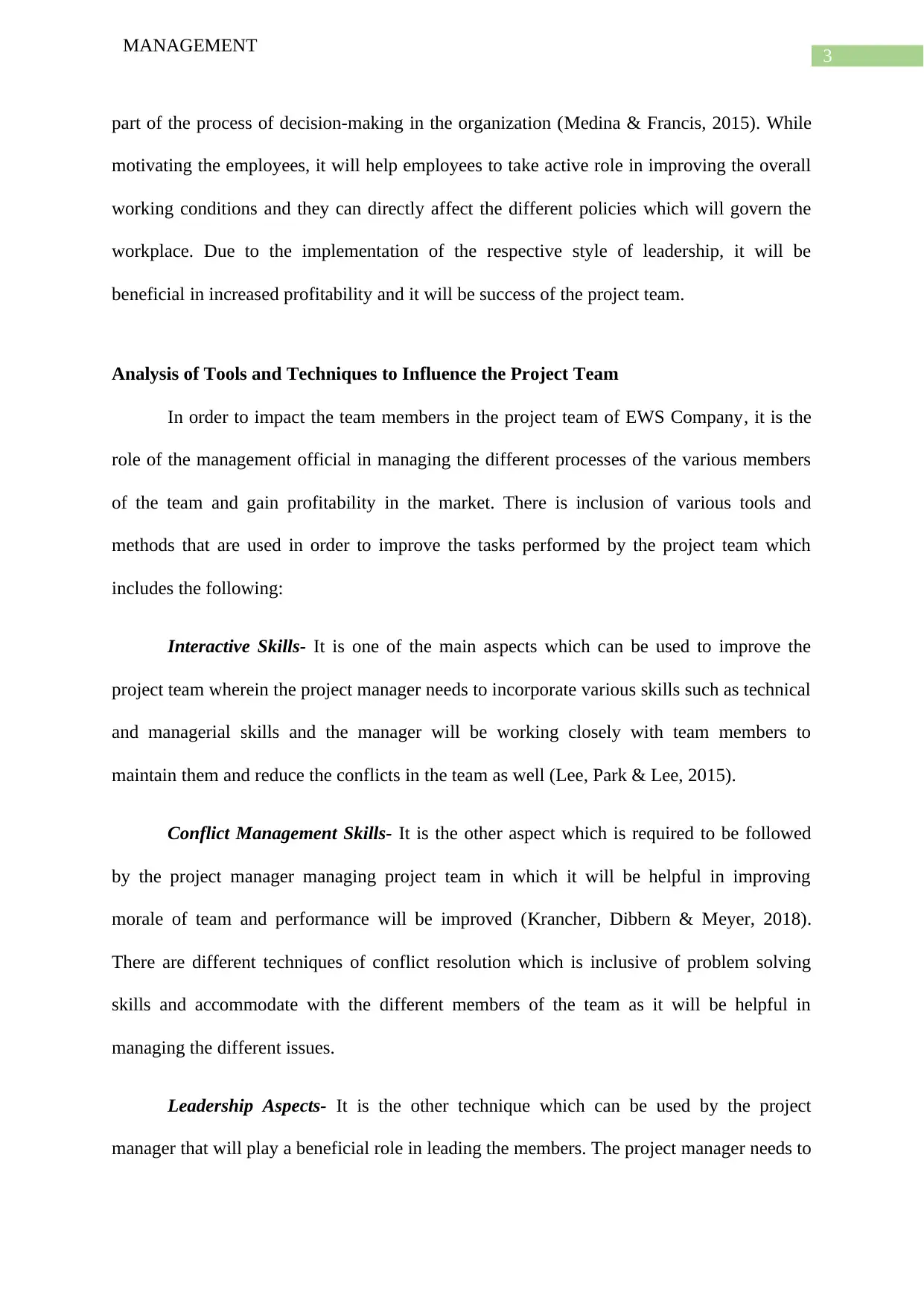
3
MANAGEMENT
part of the process of decision-making in the organization (Medina & Francis, 2015). While
motivating the employees, it will help employees to take active role in improving the overall
working conditions and they can directly affect the different policies which will govern the
workplace. Due to the implementation of the respective style of leadership, it will be
beneficial in increased profitability and it will be success of the project team.
Analysis of Tools and Techniques to Influence the Project Team
In order to impact the team members in the project team of EWS Company, it is the
role of the management official in managing the different processes of the various members
of the team and gain profitability in the market. There is inclusion of various tools and
methods that are used in order to improve the tasks performed by the project team which
includes the following:
Interactive Skills- It is one of the main aspects which can be used to improve the
project team wherein the project manager needs to incorporate various skills such as technical
and managerial skills and the manager will be working closely with team members to
maintain them and reduce the conflicts in the team as well (Lee, Park & Lee, 2015).
Conflict Management Skills- It is the other aspect which is required to be followed
by the project manager managing project team in which it will be helpful in improving
morale of team and performance will be improved (Krancher, Dibbern & Meyer, 2018).
There are different techniques of conflict resolution which is inclusive of problem solving
skills and accommodate with the different members of the team as it will be helpful in
managing the different issues.
Leadership Aspects- It is the other technique which can be used by the project
manager that will play a beneficial role in leading the members. The project manager needs to
MANAGEMENT
part of the process of decision-making in the organization (Medina & Francis, 2015). While
motivating the employees, it will help employees to take active role in improving the overall
working conditions and they can directly affect the different policies which will govern the
workplace. Due to the implementation of the respective style of leadership, it will be
beneficial in increased profitability and it will be success of the project team.
Analysis of Tools and Techniques to Influence the Project Team
In order to impact the team members in the project team of EWS Company, it is the
role of the management official in managing the different processes of the various members
of the team and gain profitability in the market. There is inclusion of various tools and
methods that are used in order to improve the tasks performed by the project team which
includes the following:
Interactive Skills- It is one of the main aspects which can be used to improve the
project team wherein the project manager needs to incorporate various skills such as technical
and managerial skills and the manager will be working closely with team members to
maintain them and reduce the conflicts in the team as well (Lee, Park & Lee, 2015).
Conflict Management Skills- It is the other aspect which is required to be followed
by the project manager managing project team in which it will be helpful in improving
morale of team and performance will be improved (Krancher, Dibbern & Meyer, 2018).
There are different techniques of conflict resolution which is inclusive of problem solving
skills and accommodate with the different members of the team as it will be helpful in
managing the different issues.
Leadership Aspects- It is the other technique which can be used by the project
manager that will play a beneficial role in leading the members. The project manager needs to
Paraphrase This Document
Need a fresh take? Get an instant paraphrase of this document with our AI Paraphraser
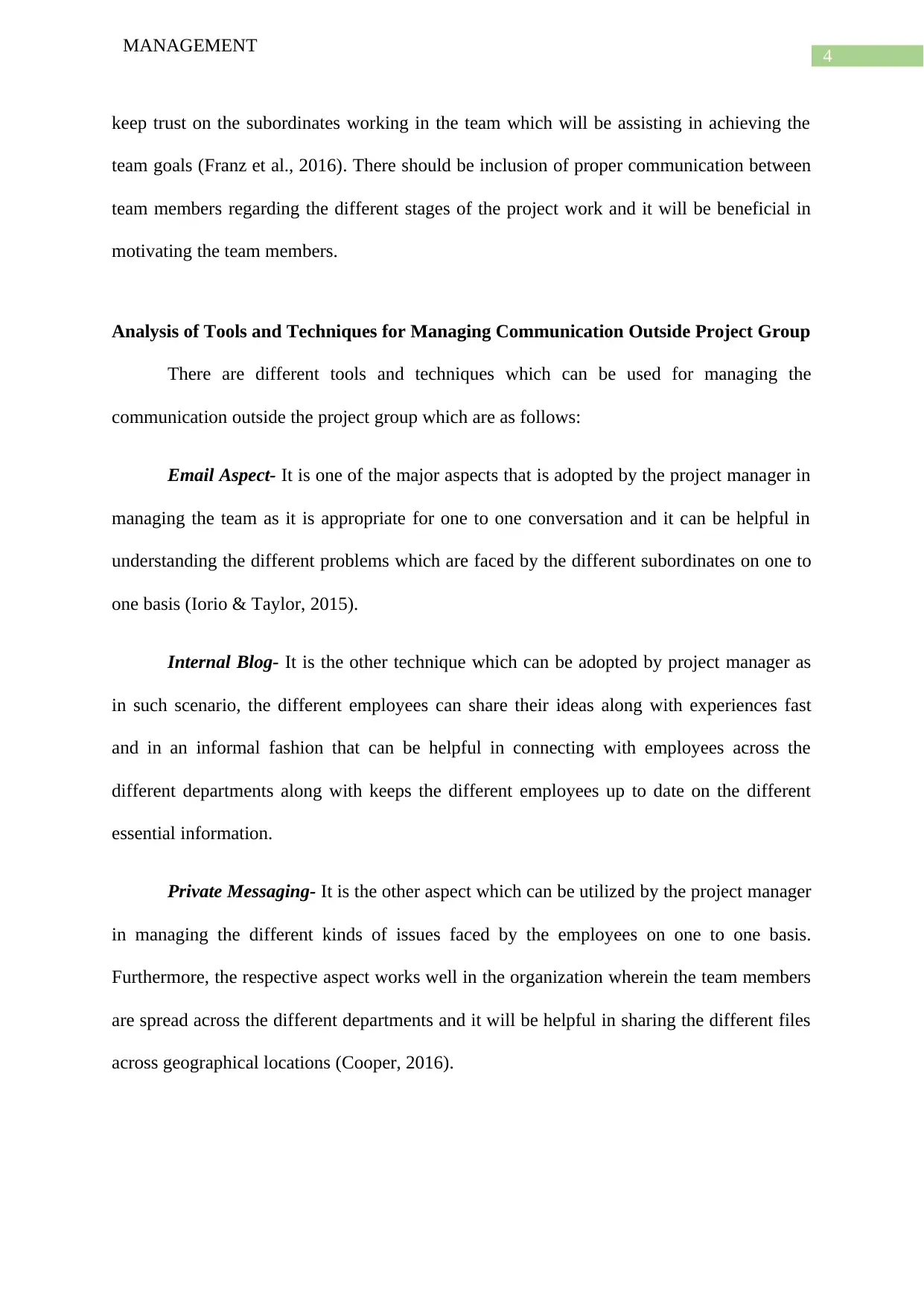
4
MANAGEMENT
keep trust on the subordinates working in the team which will be assisting in achieving the
team goals (Franz et al., 2016). There should be inclusion of proper communication between
team members regarding the different stages of the project work and it will be beneficial in
motivating the team members.
Analysis of Tools and Techniques for Managing Communication Outside Project Group
There are different tools and techniques which can be used for managing the
communication outside the project group which are as follows:
Email Aspect- It is one of the major aspects that is adopted by the project manager in
managing the team as it is appropriate for one to one conversation and it can be helpful in
understanding the different problems which are faced by the different subordinates on one to
one basis (Iorio & Taylor, 2015).
Internal Blog- It is the other technique which can be adopted by project manager as
in such scenario, the different employees can share their ideas along with experiences fast
and in an informal fashion that can be helpful in connecting with employees across the
different departments along with keeps the different employees up to date on the different
essential information.
Private Messaging- It is the other aspect which can be utilized by the project manager
in managing the different kinds of issues faced by the employees on one to one basis.
Furthermore, the respective aspect works well in the organization wherein the team members
are spread across the different departments and it will be helpful in sharing the different files
across geographical locations (Cooper, 2016).
MANAGEMENT
keep trust on the subordinates working in the team which will be assisting in achieving the
team goals (Franz et al., 2016). There should be inclusion of proper communication between
team members regarding the different stages of the project work and it will be beneficial in
motivating the team members.
Analysis of Tools and Techniques for Managing Communication Outside Project Group
There are different tools and techniques which can be used for managing the
communication outside the project group which are as follows:
Email Aspect- It is one of the major aspects that is adopted by the project manager in
managing the team as it is appropriate for one to one conversation and it can be helpful in
understanding the different problems which are faced by the different subordinates on one to
one basis (Iorio & Taylor, 2015).
Internal Blog- It is the other technique which can be adopted by project manager as
in such scenario, the different employees can share their ideas along with experiences fast
and in an informal fashion that can be helpful in connecting with employees across the
different departments along with keeps the different employees up to date on the different
essential information.
Private Messaging- It is the other aspect which can be utilized by the project manager
in managing the different kinds of issues faced by the employees on one to one basis.
Furthermore, the respective aspect works well in the organization wherein the team members
are spread across the different departments and it will be helpful in sharing the different files
across geographical locations (Cooper, 2016).
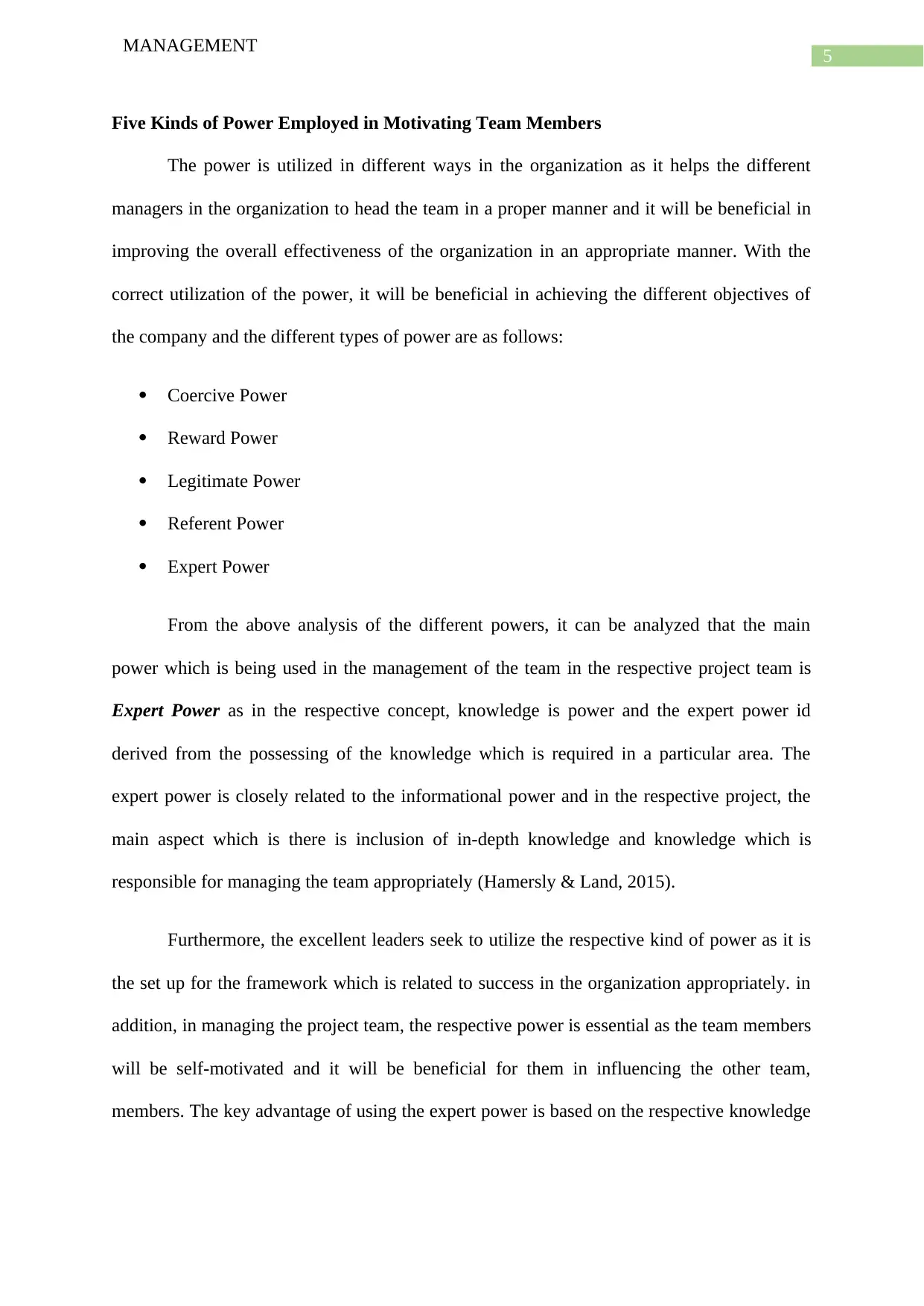
5
MANAGEMENT
Five Kinds of Power Employed in Motivating Team Members
The power is utilized in different ways in the organization as it helps the different
managers in the organization to head the team in a proper manner and it will be beneficial in
improving the overall effectiveness of the organization in an appropriate manner. With the
correct utilization of the power, it will be beneficial in achieving the different objectives of
the company and the different types of power are as follows:
Coercive Power
Reward Power
Legitimate Power
Referent Power
Expert Power
From the above analysis of the different powers, it can be analyzed that the main
power which is being used in the management of the team in the respective project team is
Expert Power as in the respective concept, knowledge is power and the expert power id
derived from the possessing of the knowledge which is required in a particular area. The
expert power is closely related to the informational power and in the respective project, the
main aspect which is there is inclusion of in-depth knowledge and knowledge which is
responsible for managing the team appropriately (Hamersly & Land, 2015).
Furthermore, the excellent leaders seek to utilize the respective kind of power as it is
the set up for the framework which is related to success in the organization appropriately. in
addition, in managing the project team, the respective power is essential as the team members
will be self-motivated and it will be beneficial for them in influencing the other team,
members. The key advantage of using the expert power is based on the respective knowledge
MANAGEMENT
Five Kinds of Power Employed in Motivating Team Members
The power is utilized in different ways in the organization as it helps the different
managers in the organization to head the team in a proper manner and it will be beneficial in
improving the overall effectiveness of the organization in an appropriate manner. With the
correct utilization of the power, it will be beneficial in achieving the different objectives of
the company and the different types of power are as follows:
Coercive Power
Reward Power
Legitimate Power
Referent Power
Expert Power
From the above analysis of the different powers, it can be analyzed that the main
power which is being used in the management of the team in the respective project team is
Expert Power as in the respective concept, knowledge is power and the expert power id
derived from the possessing of the knowledge which is required in a particular area. The
expert power is closely related to the informational power and in the respective project, the
main aspect which is there is inclusion of in-depth knowledge and knowledge which is
responsible for managing the team appropriately (Hamersly & Land, 2015).
Furthermore, the excellent leaders seek to utilize the respective kind of power as it is
the set up for the framework which is related to success in the organization appropriately. in
addition, in managing the project team, the respective power is essential as the team members
will be self-motivated and it will be beneficial for them in influencing the other team,
members. The key advantage of using the expert power is based on the respective knowledge
⊘ This is a preview!⊘
Do you want full access?
Subscribe today to unlock all pages.

Trusted by 1+ million students worldwide
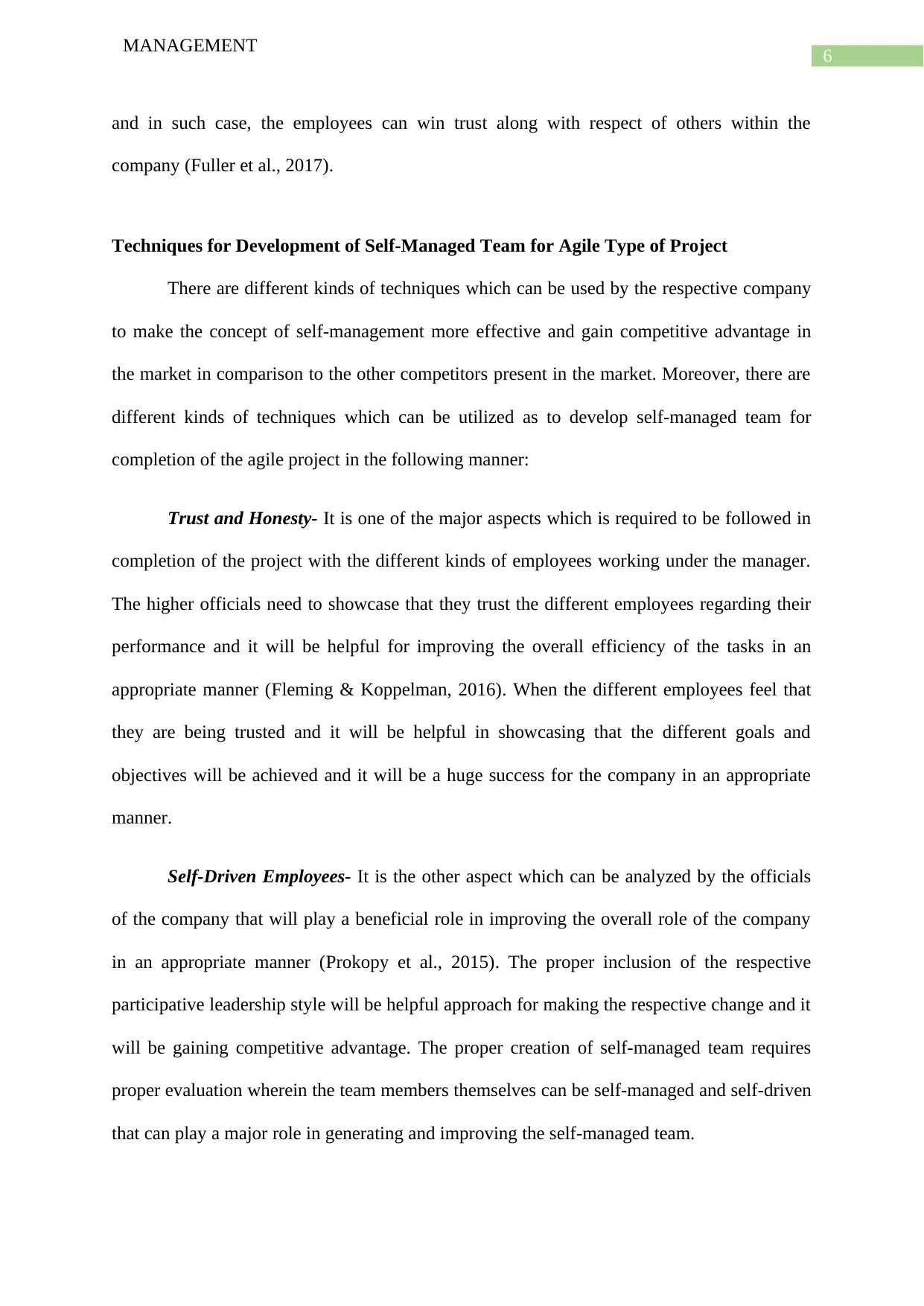
6
MANAGEMENT
and in such case, the employees can win trust along with respect of others within the
company (Fuller et al., 2017).
Techniques for Development of Self-Managed Team for Agile Type of Project
There are different kinds of techniques which can be used by the respective company
to make the concept of self-management more effective and gain competitive advantage in
the market in comparison to the other competitors present in the market. Moreover, there are
different kinds of techniques which can be utilized as to develop self-managed team for
completion of the agile project in the following manner:
Trust and Honesty- It is one of the major aspects which is required to be followed in
completion of the project with the different kinds of employees working under the manager.
The higher officials need to showcase that they trust the different employees regarding their
performance and it will be helpful for improving the overall efficiency of the tasks in an
appropriate manner (Fleming & Koppelman, 2016). When the different employees feel that
they are being trusted and it will be helpful in showcasing that the different goals and
objectives will be achieved and it will be a huge success for the company in an appropriate
manner.
Self-Driven Employees- It is the other aspect which can be analyzed by the officials
of the company that will play a beneficial role in improving the overall role of the company
in an appropriate manner (Prokopy et al., 2015). The proper inclusion of the respective
participative leadership style will be helpful approach for making the respective change and it
will be gaining competitive advantage. The proper creation of self-managed team requires
proper evaluation wherein the team members themselves can be self-managed and self-driven
that can play a major role in generating and improving the self-managed team.
MANAGEMENT
and in such case, the employees can win trust along with respect of others within the
company (Fuller et al., 2017).
Techniques for Development of Self-Managed Team for Agile Type of Project
There are different kinds of techniques which can be used by the respective company
to make the concept of self-management more effective and gain competitive advantage in
the market in comparison to the other competitors present in the market. Moreover, there are
different kinds of techniques which can be utilized as to develop self-managed team for
completion of the agile project in the following manner:
Trust and Honesty- It is one of the major aspects which is required to be followed in
completion of the project with the different kinds of employees working under the manager.
The higher officials need to showcase that they trust the different employees regarding their
performance and it will be helpful for improving the overall efficiency of the tasks in an
appropriate manner (Fleming & Koppelman, 2016). When the different employees feel that
they are being trusted and it will be helpful in showcasing that the different goals and
objectives will be achieved and it will be a huge success for the company in an appropriate
manner.
Self-Driven Employees- It is the other aspect which can be analyzed by the officials
of the company that will play a beneficial role in improving the overall role of the company
in an appropriate manner (Prokopy et al., 2015). The proper inclusion of the respective
participative leadership style will be helpful approach for making the respective change and it
will be gaining competitive advantage. The proper creation of self-managed team requires
proper evaluation wherein the team members themselves can be self-managed and self-driven
that can play a major role in generating and improving the self-managed team.
Paraphrase This Document
Need a fresh take? Get an instant paraphrase of this document with our AI Paraphraser
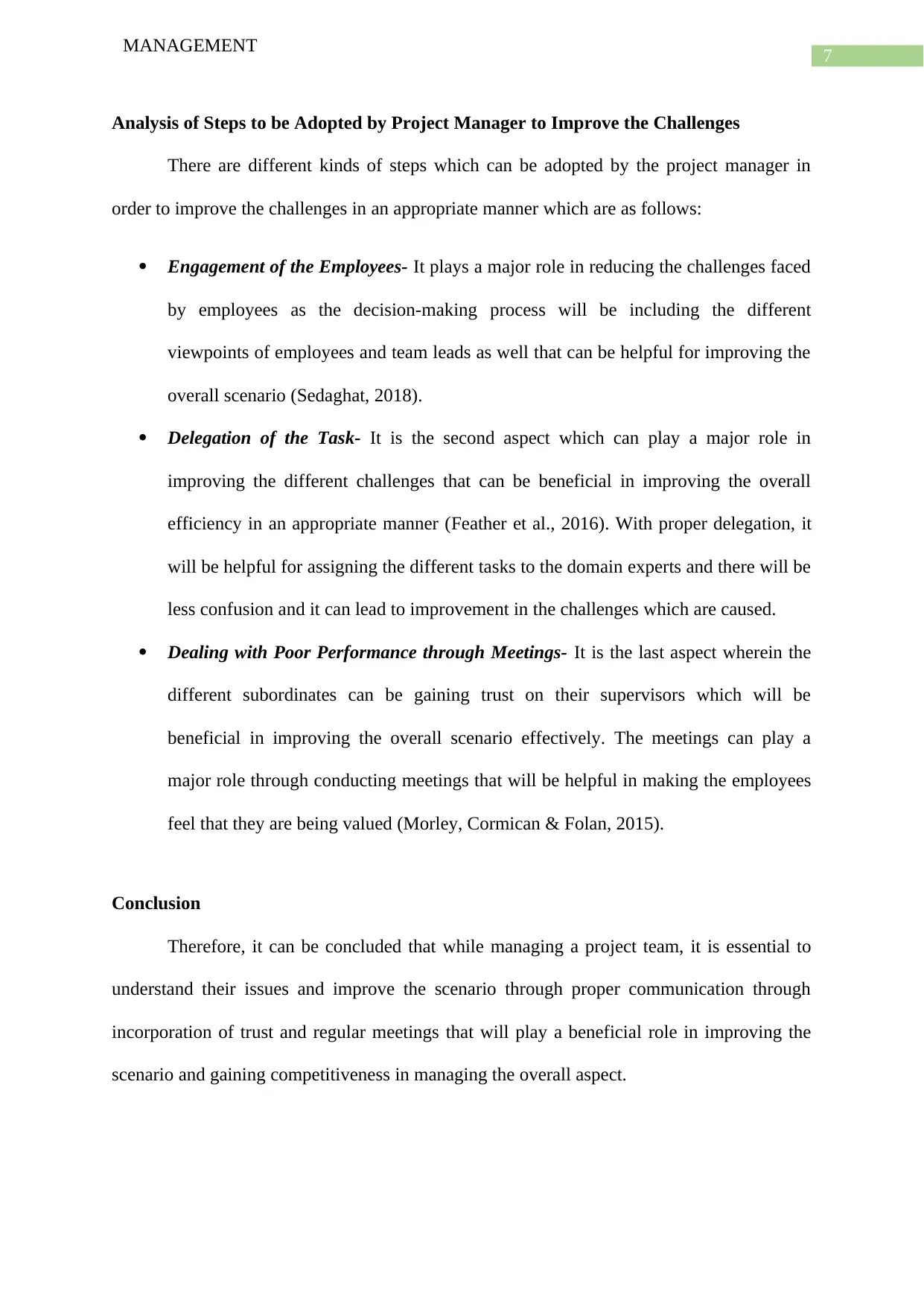
7
MANAGEMENT
Analysis of Steps to be Adopted by Project Manager to Improve the Challenges
There are different kinds of steps which can be adopted by the project manager in
order to improve the challenges in an appropriate manner which are as follows:
Engagement of the Employees- It plays a major role in reducing the challenges faced
by employees as the decision-making process will be including the different
viewpoints of employees and team leads as well that can be helpful for improving the
overall scenario (Sedaghat, 2018).
Delegation of the Task- It is the second aspect which can play a major role in
improving the different challenges that can be beneficial in improving the overall
efficiency in an appropriate manner (Feather et al., 2016). With proper delegation, it
will be helpful for assigning the different tasks to the domain experts and there will be
less confusion and it can lead to improvement in the challenges which are caused.
Dealing with Poor Performance through Meetings- It is the last aspect wherein the
different subordinates can be gaining trust on their supervisors which will be
beneficial in improving the overall scenario effectively. The meetings can play a
major role through conducting meetings that will be helpful in making the employees
feel that they are being valued (Morley, Cormican & Folan, 2015).
Conclusion
Therefore, it can be concluded that while managing a project team, it is essential to
understand their issues and improve the scenario through proper communication through
incorporation of trust and regular meetings that will play a beneficial role in improving the
scenario and gaining competitiveness in managing the overall aspect.
MANAGEMENT
Analysis of Steps to be Adopted by Project Manager to Improve the Challenges
There are different kinds of steps which can be adopted by the project manager in
order to improve the challenges in an appropriate manner which are as follows:
Engagement of the Employees- It plays a major role in reducing the challenges faced
by employees as the decision-making process will be including the different
viewpoints of employees and team leads as well that can be helpful for improving the
overall scenario (Sedaghat, 2018).
Delegation of the Task- It is the second aspect which can play a major role in
improving the different challenges that can be beneficial in improving the overall
efficiency in an appropriate manner (Feather et al., 2016). With proper delegation, it
will be helpful for assigning the different tasks to the domain experts and there will be
less confusion and it can lead to improvement in the challenges which are caused.
Dealing with Poor Performance through Meetings- It is the last aspect wherein the
different subordinates can be gaining trust on their supervisors which will be
beneficial in improving the overall scenario effectively. The meetings can play a
major role through conducting meetings that will be helpful in making the employees
feel that they are being valued (Morley, Cormican & Folan, 2015).
Conclusion
Therefore, it can be concluded that while managing a project team, it is essential to
understand their issues and improve the scenario through proper communication through
incorporation of trust and regular meetings that will play a beneficial role in improving the
scenario and gaining competitiveness in managing the overall aspect.
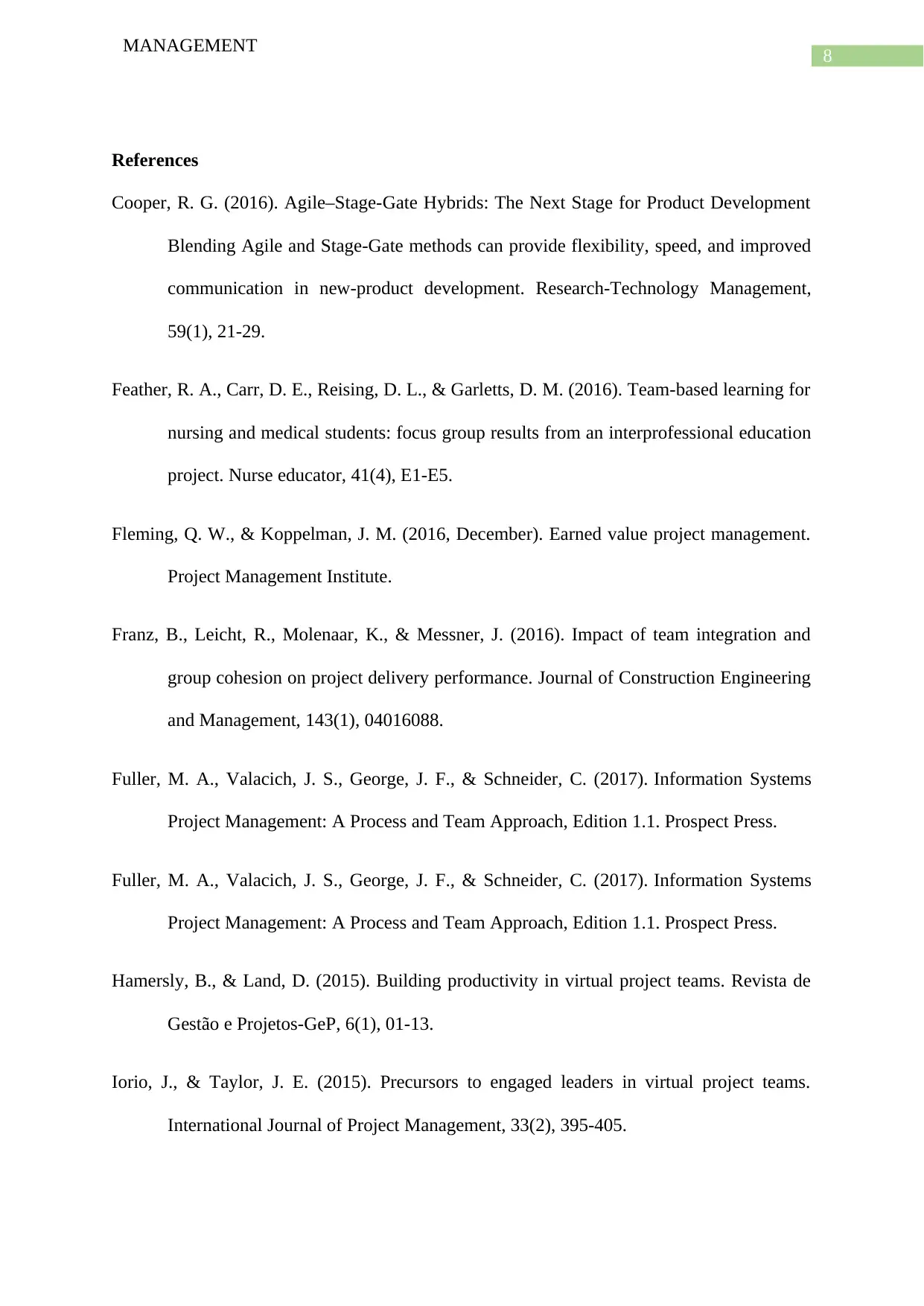
8
MANAGEMENT
References
Cooper, R. G. (2016). Agile–Stage-Gate Hybrids: The Next Stage for Product Development
Blending Agile and Stage-Gate methods can provide flexibility, speed, and improved
communication in new-product development. Research-Technology Management,
59(1), 21-29.
Feather, R. A., Carr, D. E., Reising, D. L., & Garletts, D. M. (2016). Team-based learning for
nursing and medical students: focus group results from an interprofessional education
project. Nurse educator, 41(4), E1-E5.
Fleming, Q. W., & Koppelman, J. M. (2016, December). Earned value project management.
Project Management Institute.
Franz, B., Leicht, R., Molenaar, K., & Messner, J. (2016). Impact of team integration and
group cohesion on project delivery performance. Journal of Construction Engineering
and Management, 143(1), 04016088.
Fuller, M. A., Valacich, J. S., George, J. F., & Schneider, C. (2017). Information Systems
Project Management: A Process and Team Approach, Edition 1.1. Prospect Press.
Fuller, M. A., Valacich, J. S., George, J. F., & Schneider, C. (2017). Information Systems
Project Management: A Process and Team Approach, Edition 1.1. Prospect Press.
Hamersly, B., & Land, D. (2015). Building productivity in virtual project teams. Revista de
Gestão e Projetos-GeP, 6(1), 01-13.
Iorio, J., & Taylor, J. E. (2015). Precursors to engaged leaders in virtual project teams.
International Journal of Project Management, 33(2), 395-405.
MANAGEMENT
References
Cooper, R. G. (2016). Agile–Stage-Gate Hybrids: The Next Stage for Product Development
Blending Agile and Stage-Gate methods can provide flexibility, speed, and improved
communication in new-product development. Research-Technology Management,
59(1), 21-29.
Feather, R. A., Carr, D. E., Reising, D. L., & Garletts, D. M. (2016). Team-based learning for
nursing and medical students: focus group results from an interprofessional education
project. Nurse educator, 41(4), E1-E5.
Fleming, Q. W., & Koppelman, J. M. (2016, December). Earned value project management.
Project Management Institute.
Franz, B., Leicht, R., Molenaar, K., & Messner, J. (2016). Impact of team integration and
group cohesion on project delivery performance. Journal of Construction Engineering
and Management, 143(1), 04016088.
Fuller, M. A., Valacich, J. S., George, J. F., & Schneider, C. (2017). Information Systems
Project Management: A Process and Team Approach, Edition 1.1. Prospect Press.
Fuller, M. A., Valacich, J. S., George, J. F., & Schneider, C. (2017). Information Systems
Project Management: A Process and Team Approach, Edition 1.1. Prospect Press.
Hamersly, B., & Land, D. (2015). Building productivity in virtual project teams. Revista de
Gestão e Projetos-GeP, 6(1), 01-13.
Iorio, J., & Taylor, J. E. (2015). Precursors to engaged leaders in virtual project teams.
International Journal of Project Management, 33(2), 395-405.
⊘ This is a preview!⊘
Do you want full access?
Subscribe today to unlock all pages.

Trusted by 1+ million students worldwide
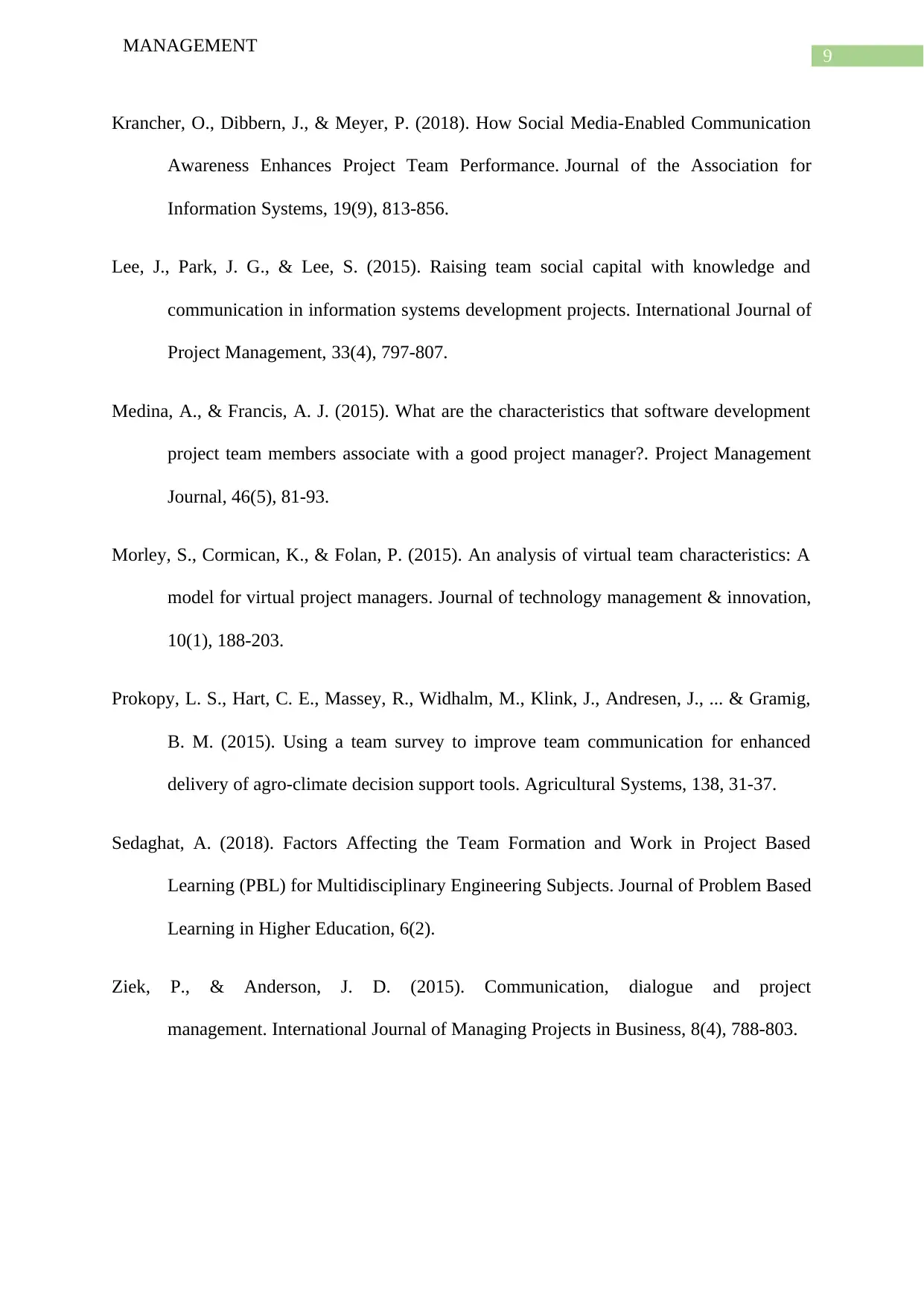
9
MANAGEMENT
Krancher, O., Dibbern, J., & Meyer, P. (2018). How Social Media-Enabled Communication
Awareness Enhances Project Team Performance. Journal of the Association for
Information Systems, 19(9), 813-856.
Lee, J., Park, J. G., & Lee, S. (2015). Raising team social capital with knowledge and
communication in information systems development projects. International Journal of
Project Management, 33(4), 797-807.
Medina, A., & Francis, A. J. (2015). What are the characteristics that software development
project team members associate with a good project manager?. Project Management
Journal, 46(5), 81-93.
Morley, S., Cormican, K., & Folan, P. (2015). An analysis of virtual team characteristics: A
model for virtual project managers. Journal of technology management & innovation,
10(1), 188-203.
Prokopy, L. S., Hart, C. E., Massey, R., Widhalm, M., Klink, J., Andresen, J., ... & Gramig,
B. M. (2015). Using a team survey to improve team communication for enhanced
delivery of agro-climate decision support tools. Agricultural Systems, 138, 31-37.
Sedaghat, A. (2018). Factors Affecting the Team Formation and Work in Project Based
Learning (PBL) for Multidisciplinary Engineering Subjects. Journal of Problem Based
Learning in Higher Education, 6(2).
Ziek, P., & Anderson, J. D. (2015). Communication, dialogue and project
management. International Journal of Managing Projects in Business, 8(4), 788-803.
MANAGEMENT
Krancher, O., Dibbern, J., & Meyer, P. (2018). How Social Media-Enabled Communication
Awareness Enhances Project Team Performance. Journal of the Association for
Information Systems, 19(9), 813-856.
Lee, J., Park, J. G., & Lee, S. (2015). Raising team social capital with knowledge and
communication in information systems development projects. International Journal of
Project Management, 33(4), 797-807.
Medina, A., & Francis, A. J. (2015). What are the characteristics that software development
project team members associate with a good project manager?. Project Management
Journal, 46(5), 81-93.
Morley, S., Cormican, K., & Folan, P. (2015). An analysis of virtual team characteristics: A
model for virtual project managers. Journal of technology management & innovation,
10(1), 188-203.
Prokopy, L. S., Hart, C. E., Massey, R., Widhalm, M., Klink, J., Andresen, J., ... & Gramig,
B. M. (2015). Using a team survey to improve team communication for enhanced
delivery of agro-climate decision support tools. Agricultural Systems, 138, 31-37.
Sedaghat, A. (2018). Factors Affecting the Team Formation and Work in Project Based
Learning (PBL) for Multidisciplinary Engineering Subjects. Journal of Problem Based
Learning in Higher Education, 6(2).
Ziek, P., & Anderson, J. D. (2015). Communication, dialogue and project
management. International Journal of Managing Projects in Business, 8(4), 788-803.
1 out of 10
Related Documents
Your All-in-One AI-Powered Toolkit for Academic Success.
+13062052269
info@desklib.com
Available 24*7 on WhatsApp / Email
![[object Object]](/_next/static/media/star-bottom.7253800d.svg)
Unlock your academic potential
Copyright © 2020–2025 A2Z Services. All Rights Reserved. Developed and managed by ZUCOL.




